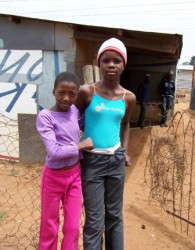Soweto’s Shantytowns

To fully understand South Africa’s experience with Apartheid (racial segregation), we were taken to Soweto. Originally a mining area, it became a place where poor Africans would be concentrated in shacks. More than 30,000 people are concentrated in a very dense area. I was surprised that this was considered a tourist attraction but the idea is for people to not leave the country without appreciating this side of it. It’s also an opportunity for the residents to get money from tourists.
Earlier in the week, our guide, Elsabe, explained public policies related to housing and the nation’s promise to provide homes for all. Vote for Mandela, and those in shacks will get houses. One million units were promised and 600,000 have been built so far. But refugees from other African countries have been pouring in seeking shelter. The difference in being in a shack in a designated area versus the countryside is access to police protection and transportation, jobs and better schools. The goal is to not have any more shacks by 2014. An estimated 15 percent of the population is in shacks.
We also visited a plaza that is an open market and a space for freedom. Inside a brick monument are 10 Commandments that are like a Bill of Rights, expressing the country’s objectives for its people and how it will achieve equal rights.
The nearby Hector Peterson Museum commemorates the students who were shot during riots in 1976, when students and educators were protesting being forced to teach in the Dutch Afrikaans language versus native languages. The majority of South Africans speak Zulu and there are at least nine official languages today.
We had a traditional lunch in Soweto at the Sakhumzi Restaurant’s buffet. On the street corner there were children dancing for money. We were serenaded by a woman with a beautiful voice accompanied by a guitarist. She sang native songs, pop songs and jazzy ones. I was hoping she had CDs to sell, but she didn’t. So I did video tape her for about two minutes.
The Apartheid museum was very compelling and well presented. At the entrance, visitors were handed passes that indicated whether they were whites or nonwhites and they entered segregated entrances. We learned about the people and policies involved in constructing and eliminating Apartheid policies and the triumph of democracy in 1994.
The really sad unintended consequence that was most obvious is how the city of Johannesburg is completely overrun with crime and decay 14 years later. All the wealth and businesses transferred to a brand new city called Sandton. So the country went from an oppressive regime to a powerless one rather quickly. I hope the pendulum can swing back to the middle someday.
We spent our last night eating at a very nice African restaurant called Moyo. Food was served family style and we all go tour faces painted before heading to the airport. It was great fun. Reinoud and Rian Hagen from Fides were terrific hosts and I believe this was the best possible way to experience South Africa. It truly was a chance of a lifetime.









